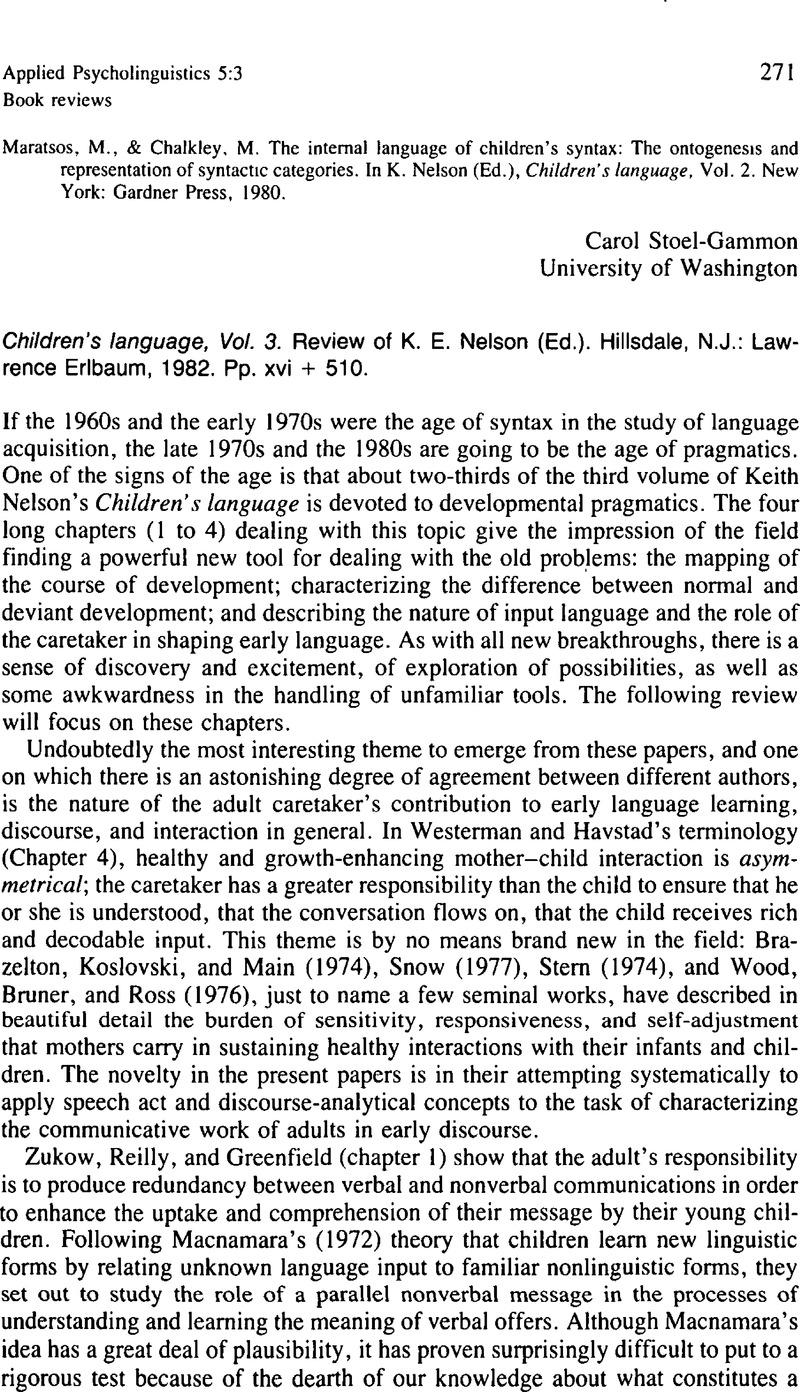No CrossRef data available.
Article contents
Children’s language, Vol. 3. Review of K. E. Nelson (Ed.). Hillsdale, N.J.: Lawrence Erlbaum, 1982. Pp. xvi + 510.
Published online by Cambridge University Press: 28 November 2008
Abstract
An abstract is not available for this content so a preview has been provided. Please use the Get access link above for information on how to access this content.

- Type
- Book Reviews
- Information
- Copyright
- Copyright © Cambridge University Press 1984
References
REFERENCES
Bloom, L. Of continuity and discontinuity, and the magic of language development. In Golinkoff, R. M. (Ed.), The transilion from prelinguistic to linguistic communication. Hillsdale, N.J.: Lawrence Erlbaum, 1983.Google Scholar
Brazelton, T. B., Koslovski, B., & Main, M. The origins of reciprocity: The early mother-infant interaction. In Lewis, M. & Rosenblum, L. A. (Eds.), The effect of the infant on its caregiver. New York: Wiley-Interscience, 1974, pp. 49–76.Google Scholar
Cromer, R. Reconceptualizing language acquisition and cognitive development. In Schieffelbusch, R. & Bricker, D. (Eds.), Early language: Acquisition and intervention. Baltimore: University Park Press, 1981.Google Scholar
Cross, T. Motherese: Its association with the rate of syntactic acquisition in young children. In Waterson, N. & Snow, C. (Eds.), The development of communication. London: Wiley, 1978.Google Scholar
Gleitman, L. R., and Wanner, E. Language acquisition: The state of the state of the art. In Wanner, E. & Gleitman, L. R. (Eds.), Language acquisition: The state of the art. Cambridge: Cambridge University Press, 1982.Google Scholar
Macnamara, J.Cognitive basis of language learning in infants. Psychological Review, 1972, 79, 1–14.Google Scholar
Searle, J. R. A taxonomy of illocutionary acts. In Gunderson, K., (Ed.), Minnesota Studies in the Philosophy of Science, Vol. 7. Minneapolis: University of Minnesota Press, 1975, pp. 344–369.Google Scholar
Shatz, M. On mechanisms of language acquisition: Can features of the communicative environment account for development? In Wanner, E. & Gleitman, L. R. (Eds.), Language acquisition: The state of the art. Cambridge: Cambridge University Press, 1982.Google Scholar
Snow, C. E.The development of conversation between mothers and babies. Journal of Child Language, 1977, 4, 1–22.CrossRefGoogle Scholar
Stern, D. N. Mother and infant at play: The dyadic interaction involving facial, vocal and gaze behaviors. In Lewis, M. & Rosenblum, L. A. (Eds.), The effect of the infant on its caregiver. New York: Wiley-Interscience, 1974, pp. 49–76.Google Scholar
Wood, D., Bruner, J., & Ross, G.The role of tutoring in problem solving. Journal of Child Psychology and Psychiatry, 1976, 17, 89–100.CrossRefGoogle ScholarPubMed


